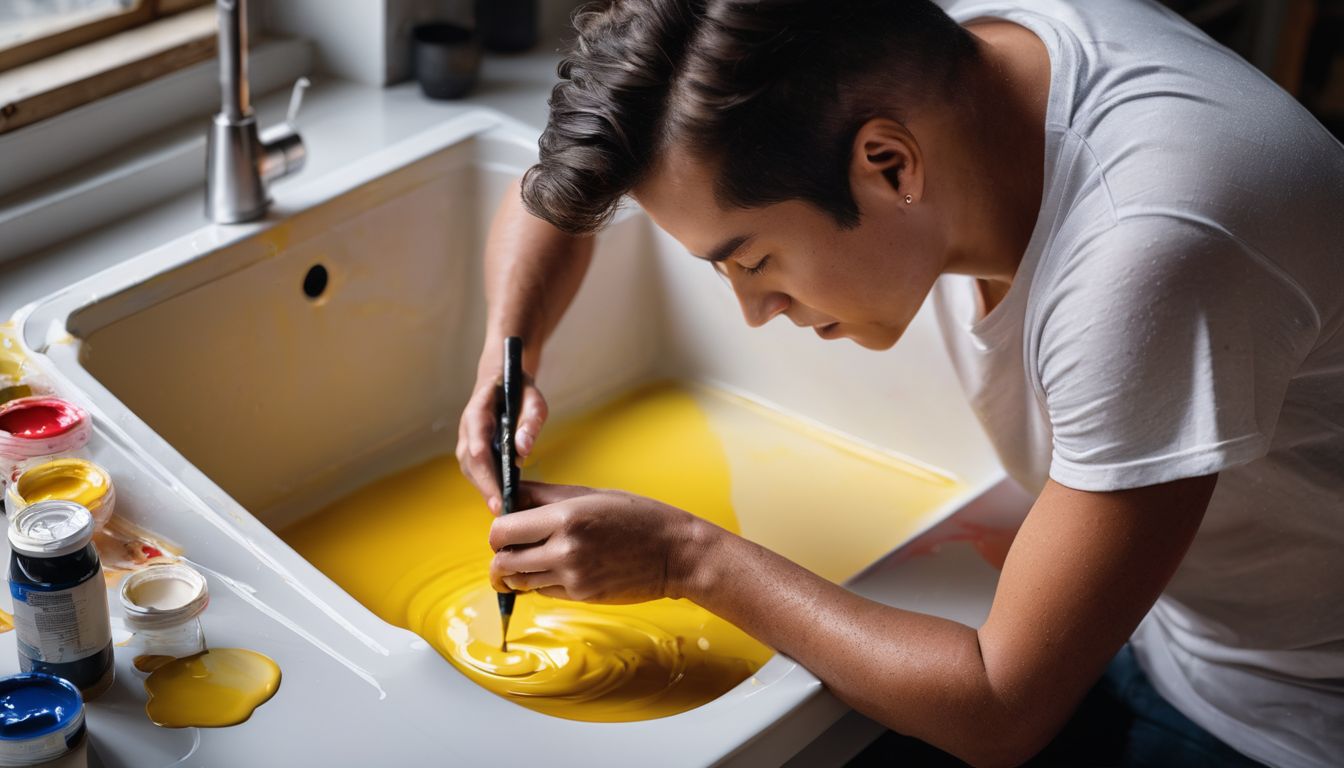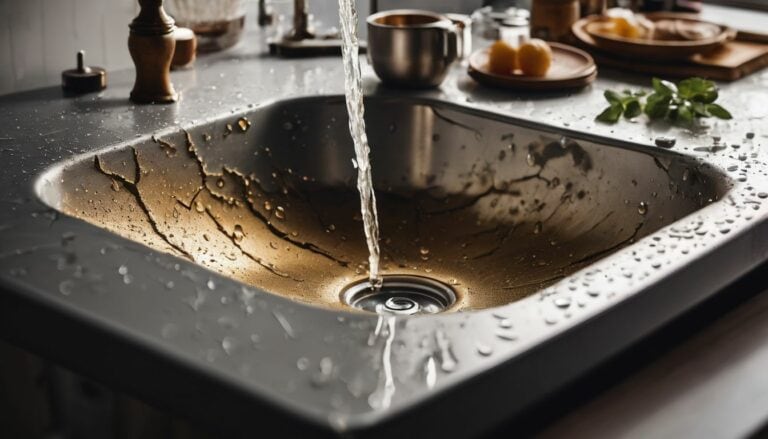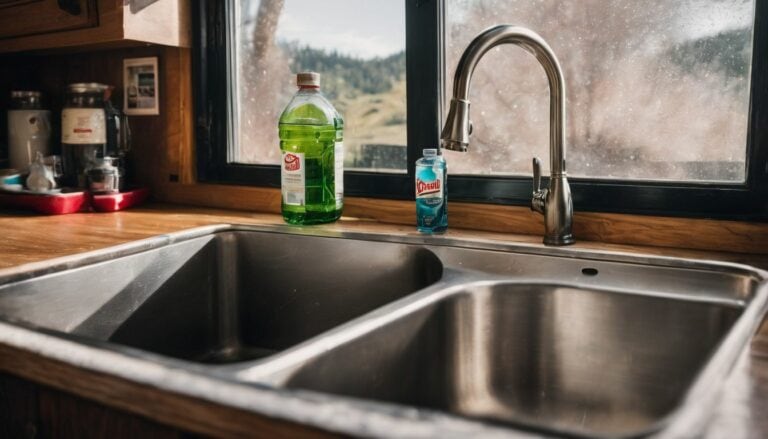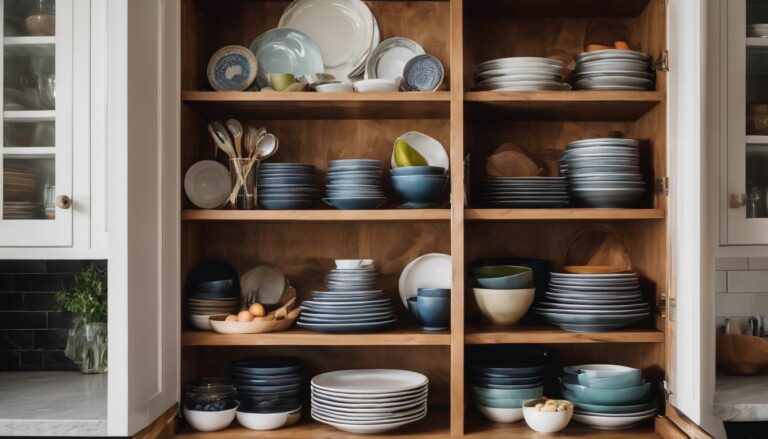Can You Paint a Plastic Kitchen Sink: Revamp Your Kitchen For A Makeover?
Do you ever find yourself sighing at the sight of your lackluster, discolored kitchen sink? Don’t worry – I empathize with that sentiment. Replacement costs can be a real setback. But fear not! After considerable trial and error and thorough research, I’ve unearthed a pocket-friendly solution to this household woe: just paint it! Let me walk you through an easy guide on how to revitalize your old sink into something spick-and-span using some paint and a bit of elbow grease.
Are you ready? So let’s roll up our sleeves and get started, shall we?.
Key Takeaways
- Yes, plastic kitchen sinks can be painted using the right type of paint.
- To paint a plastic sink, you will need supplies like acrylic paint, sandpaper, painter’s tape, primer, and protective gear.
- Properly preparing the sink by cleaning and sanding it is important for a successful paint job.
- Taping out necessary parts before painting helps protect them from getting painted.
- Using the right primer designed for plastic surfaces is crucial to ensure proper adhesion of the paint.
- Applying multiple thin coats of acrylic paint provides better coverage and a smooth finish on the sink.
- Letting the paint dry completely before moving on to the next step is important.
- Plastic kitchen sinks can be painted using acrylic paint designed for plastic surfaces.
- Prepare the sink by cleaning it thoroughly and smoothing its surface with sandpaper.
- Tape off areas that should not be painted to protect them during the painting process.
- Apply a primer designed for plastic surfaces to ensure good adhesion of the paint.
- Use multiple thin coats of acrylic paint for optimal coverage and a smooth finish.
- Allow each coat of paint to dry completely before applying additional layers or moving on to the next step
Can You Paint A Plastic Kitchen Sinks?

Yes, plastic sinks can be painted. It is a great way to give your sink a fresh new look. The key is to use the right type of paint. Acrylic paint that works on plastic surfaces should be used.
Some people don’t know this and think they are stuck with their old sink color forever. That’s not true! You can pick any color you want for your sink.
First, make sure the surface you’re going to paint has been prepared well before painting. Do it by cleaning off any dirt or grime from the sink and smooth it down with sandpaper if needed: prepping the area correctly will help get better results.
Also, use painter’s tape around areas you do not wish to have painted—like your drain or faucet—to keep them clean during painting process.
Remember to protect yourself too when using paints like Rust-Oleum; wear gloves and eye protection during this project! This ensures safety while making changes to improve your kitchen space.
Can You Paint a Plastic Kitchen Sink: What You’ll Need

To paint a plastic kitchen sink, you’ll need the following supplies: acrylic paint, sandpaper, painter’s tape, primer, a paintbrush or spray gun, and protective gear.
Acrylic paint
Acrylic paint is a great choice for your kitchen sink project. It’s made of color parts held in something called a polymer emulsion. The cool thing about acrylic paints is you can thin them with water to use.
Plus, they form a hard and shiny layer when dry. You get this look by adding more and more layers of paint.
Now, keep in mind all acrylic paints are not the same! Some are even made just to use on plastic surfaces like your sink. A brush-on type of paint works best for sinks because you need it all over the surface area, even corners.
The result will be a hard surface that shines bright under your kitchen lights.
Sandpaper
You need sandpaper for this job. It helps the paint stick to the plastic sink. Use fine-grit sandpaper with a size between 180 to 220. This size is best for plastic surfaces. You should move the paper in circles on the sink.
This way, you don’t scratch it up too much. Once done, dust off any small bits left behind using a wet cloth.
Painter’s tape
Painter’s tape is a special type of masking tape that helps protect surfaces while you paint. It’s great for covering areas like edges and corners that you don’t want to get painted on.
This tape has a light adhesive, so it sticks well to smooth surfaces like newly painted walls, glass, woodwork, and even plastic sinks. The best part is that painter’s tape reduces the risk of paint bleeding through and makes it easier to remove without damaging the surface underneath.
There are different types of painter’s tape available, such as 3M Scotch Painter’s Green Masking Tape, which works well on hard-to-stick surfaces. So when you’re doing any painting project, including painting your plastic kitchen sink, make sure to use painter’s tape for clean lines and precise coverage!
Primer
When painting a plastic kitchen sink, using a high-adhesion latex stain-blocking primer is important. This type of primer ensures that the paint adheres well to the surface and prevents stains from bleeding through.
It provides a smooth base for the paint to adhere to and improves its durability. Even if the paint claims to have a built-in primer, it’s still recommended to use a separate primer for better results.
Make sure to choose a primer specifically designed for plastic surfaces. Applying an even coat of primer on the clean and sanded surface will help create an excellent foundation for your paint job.
Paintbrush or spray gun
When painting a plastic kitchen sink, you have two options for applying the paint: a paintbrush or a spray gun. Both methods can be effective, but it’s important to choose the right tool for your project.
If you decide to use a paintbrush, make sure to select one that is suitable for acrylic paint and designed for smooth surfaces like plastic. This will help ensure an even application of the paint and minimize brush strokes.
Take your time when using a brush, working in small sections and overlapping each stroke slightly for seamless coverage.
On the other hand, if you prefer to use a spray gun, it can make the painting process quicker and more efficient. However, it’s crucial to follow proper technique and safety guidelines when using high-pressure spraying equipment.
Make sure to choose an airless spray gun specifically designed for painting plastic surfaces with acrylic paint.
Protective gear
I always make sure to wear protective gear when painting a plastic kitchen sink. This includes using a ventilation system to minimize exposure to harmful fumes and chemicals. I wear disposable gloves to protect my hands from paint and chemicals, as well as wearing protective clothing like a long-sleeved shirt and pants to prevent any contact with my skin.
It’s also important to wear a respirator mask that filters out harmful particles in the air. Personal protective equipment (PPE) should always be worn as directed for my safety while painting the sink.
Step 1: Prepare the Sink
Thoroughly cleaning and sanding the sink surface is crucial for a successful paint job. Find out how to properly prepare your plastic kitchen sink in our comprehensive step-by-step guide!
Thoroughly clean the sink
To start painting a plastic kitchen sink, it’s important to thoroughly clean the sink first. This means clearing it of any dishes or debris and scrubbing the sink basin using a scrub brush or sponge.
Make sure to also clean and shine the faucet using a cleaning solution or vinegar. Lastly, don’t forget to clean the drain by removing any clogs or buildup. By following these steps, you’ll have a clean surface ready for painting your plastic kitchen sink!
Smoothen the surface with sandpaper
To achieve a smooth and even paint finish on your plastic kitchen sink, it’s important to smoothen the surface with sandpaper. Start by using a medium-grit sandpaper, around 120-150 grit, to gently sand the entire sink.
This process creates a rough texture on the plastic surface, which helps the paint adhere better later on. Make sure to pay attention to any repaired areas or imperfections as well; you might need to use a finer grit sandpaper, around 220-320 grit, for these spots.
Sanding removes any bumps or roughness, giving your sink a smoother finish overall.
Step 2: Tape Out the Necessary Parts
Now, let’s move on to step 2: taping out the necessary parts. This is an important step in painting a plastic kitchen sink because it helps protect certain areas from getting paint on them. Here’s what you need to do:
- Get some masking tape, preferably painter’s tape, as it works best for this task.
- Start by taping off the drain area of the sink. Make sure it is covered completely so that no paint gets inside.
- Next, tape around the edges of the sink and any other areas you want to protect from paint marks.
- Take your time with this step to ensure thorough coverage and a professional finish.
Step 3: Prime the Sink
To prime the sink, choose a primer specifically designed for plastic surfaces. Apply an even coat of primer to ensure proper adhesion of the paint.
Choose the right primer
Choosing the right primer is crucial when painting a plastic kitchen sink. It’s important to find a primer specifically designed for use on plastic surfaces to ensure proper adhesion and durability of the paint.
Using the wrong type of primer can result in peeling or bubbling of the paint over time. So, make sure to read the label carefully and select a primer that is suitable for plastic materials.
This will help you achieve a smooth and long-lasting finish on your sink.
Apply an even coat
When applying primer to your plastic kitchen sink, it is important to apply an even coat. This helps create a smooth and uniform base for the paint to adhere to. By ensuring complete coverage, you can prevent bubbles or uneven texture on the final painted surface.
Take your time to carefully apply the primer in a consistent manner, making sure that every part of the sink is covered evenly. Allow the primer coat to dry completely before moving on to applying the paint.
This will help achieve better adhesion and ensure a more professional-looking finish.
Remember, using multiple thin coats of primer and paint is better than one thick coat. It promotes better drying and reduces the risk of drips or streaks. So take your time and make sure each layer is applied evenly for optimal results.
Step 4: Apply the Paint
Apply the acrylic paint designed specifically for plastic surfaces using either a paintbrush or a spray gun. Make sure to apply multiple thin coats, allowing each coat to dry before applying the next one.
Use acrylic paint designed for plastic surfaces
I recommend using acrylic paint that is specifically designed for plastic surfaces when painting your plastic kitchen sink. This type of paint is formulated to adhere well to plastic and provide a durable finish.
By using the right kind of paint, you can ensure that your painting project on the sink will be successful and long-lasting. Remember to apply multiple thin coats of the acrylic paint for best results, and follow the instructions provided by the manufacturer for drying time.
Apply multiple thin coats
For the best results, it’s important to apply multiple thin coats of paint when painting a plastic kitchen sink. This technique helps achieve optimal coverage and a smooth finish. After applying the initial coat of paint, wait 2-4 hours before applying subsequent layers.
It’s normal for the sink to look bad after the first coat, but don’t worry! By layering light and thin applications of paint, you’ll see the desired outcome in no time. Remember, patience is key when it comes to achieving a great-looking painted plastic sink!
Step 5: Let the Paint Dry
Allow the paint to dry completely before moving on to the next step. Follow the instructions provided on the paint can for specific drying times, and consider using a fan or hair dryer to speed up the process if desired.
Follow instructions for drying time
It’s important to follow the instructions for drying time when painting a plastic kitchen sink. Different types of paint and primer have different recommended drying times, so it’s crucial to read and follow the manufacturer’s instructions.
Typically, it takes around 1-2 hours for the primer to dry before moving on to the next step. If you’re using a 2-part epoxy paint, each fresh coat should dry for approximately 1 hour before applying another one.
It’s also important to allow everything to dry overnight before proceeding with any additional steps. By following the specified drying time, you’ll ensure that your painted plastic kitchen sink turns out beautifully and lasts longer.
Consider using a fan or hair dryer for faster drying
To speed up the drying process of paint on a plastic kitchen sink, you can consider using a fan or hair dryer. This tip is associated with Step 5 of the comprehensive guide for painting a plastic sink.
By using a fan or hair dryer, you can reduce the drying time of the paint, allowing for quicker completion of your project. Just make sure to set your hair dryer to a low heat setting to prevent any damage to the plastic surface.
Word Count: 84 words
Step 6: Apply a Second Coat
Applying a second coat of paint is an important step in painting a plastic kitchen sink. To achieve the best results, follow these tips:
- Properly prepare the surface before applying the second coat.
- Rinse and dry the sink to ensure good adhesion.
- Wait for the first coat to dry completely before applying the second coat.
- Use a paintbrush or a high – quality foam roller for an even application.
- Follow the recommended drying and curing process explained in Step 7.
- Allow the epoxy paint to fully cure before removing the painter’s tape.
- Consider using a sealant after applying the second coat for added protection and durability.
- Choose a paintbrush or foam roller that will help you achieve a smooth and even finish.
- Remember to follow all instructions and steps outlined in the guide.
Common Mistakes to Avoid
Avoid these common mistakes when painting a plastic kitchen sink: not properly prepping the sink, using the wrong type of paint or primer, rushing the drying process, not using protective gear, and not following instructions.
Not properly prepping the sink
One common mistake to avoid when painting a plastic kitchen sink is not properly prepping the sink. Before you start painting, it’s important to thoroughly clean and dry the surface of the sink.
This will help ensure that the paint adheres properly and lasts longer. Additionally, sanding the sink’s surface can also improve paint adhesion. By taking these prep steps, you’ll create a smooth and clean canvas for your paint job, resulting in a more professional-looking finish.
Using the wrong type of paint or primer
Using the wrong type of paint or primer can cause problems when painting a plastic kitchen sink. If the paint isn’t designed for plastic surfaces, it may not adhere properly and could peel or chip over time.
Similarly, if you use an unsuitable primer or skip priming altogether, the paint won’t stick well to the sink. It’s important to choose a paint and primer that are compatible with plastic materials to ensure long-lasting results.
Additionally, if you’re using spray paints, make sure to read and follow the instructions carefully, especially when it comes to cleanup.
Rushing the drying process
I can’t stress enough how important it is to let the paint on your plastic kitchen sink dry properly. Rushing this step can lead to peeling or an uneven finish. Take your time and follow the instructions for drying time provided by the manufacturer of the paint you’re using.
If you want to speed up the process, consider using a fan or a hair dryer on low heat, but be careful not to get too close and cause damage. Remember, patience pays off when it comes to achieving a flawless paint job on your plastic sink.
Not using protective gear
I cannot stress enough the importance of using protective gear when undertaking any painting project, including painting a plastic kitchen sink. Not using proper safety equipment can lead to serious health hazards and risks.
By not wearing protective clothing, such as gloves, goggles, and a respirator mask, you are leaving yourself vulnerable to harmful chemicals and fumes that can cause respiratory problems or skin irritations.
Safety regulations and guidelines exist for a reason – they are designed to keep you safe and protect your well-being. So please, always prioritize your personal safety by wearing the necessary protective gear when working with paints and other materials.
Age-appropriate:
It’s really important to wear the right safety gear when painting anything, even a plastic kitchen sink! If you don’t use things like gloves, goggles, or a mask while painting with chemicals or sprays on your sink (or anywhere else!), it could make you sick or hurt your skin.
Not following instructions
Not following instructions is a common mistake when painting a plastic kitchen sink. It’s important to carefully read and follow the provided directions to achieve satisfactory results.
Disregarding guidance can lead to issues such as premature chipping or peeling of the paint, as well as improper adhesion to the plastic surface. Additionally, neglecting recommended drying and curing times can affect how well the paint sticks to the sink.
It’s also crucial not to overlook protecting adjacent areas from paint splatters or spills, which is why using painter’s tape is essential. Rushing through each step without allowing ample time for preparation and drying can result in an unsatisfactory outcome.
Conclusion
In conclusion, painting a plastic kitchen sink is possible and can give your sink a fresh new look. With the right preparation and materials, you can transform your sink and make it squeaky clean again.
Follow the step-by-step guide to achieve beautiful results and enjoy your revamped kitchen sink!
FAQs
1. Can I paint a plastic kitchen sink?
Yes, you can paint a plastic kitchen sink using the right materials and following proper steps.
2. What materials do I need to paint a plastic kitchen sink?
You will need sandpaper, primer specifically made for plastic surfaces, acrylic or epoxy spray paint, painter’s tape, and clear sealant.
3. How do I prepare the plastic kitchen sink for painting?
To prepare the plastic kitchen sink for painting, clean it thoroughly with soap and water, then lightly sand the surface to help the primer adhere better.
4. What steps should I follow when painting a plastic kitchen sink?
Firstly, apply painter’s tape to protect surrounding areas. Then, apply multiple thin coats of primer and let it dry completely before applying spray paint in light even strokes. Finally, seal the painted surface with clear sealant.
5. How long does it take for the painted plastic kitchen sink to dry?
The drying time will vary depending on factors such as temperature and humidity levels but typically it takes around 24 hours for the painted surface to fully dry and cure.







